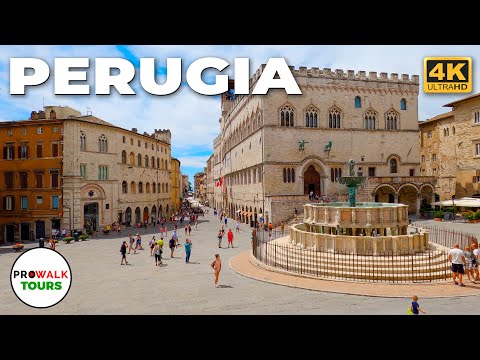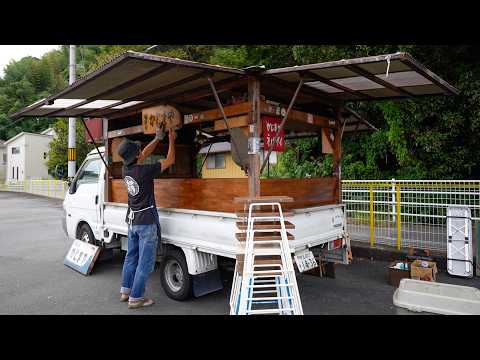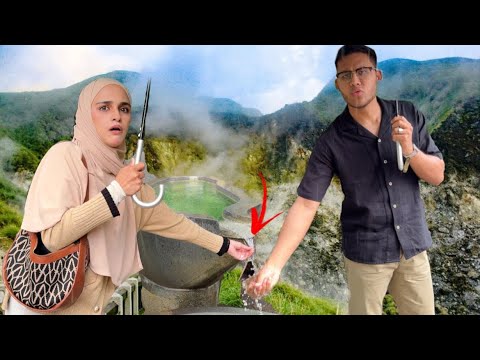Perugia, Italy Walking Tour - 4K - Prowalk Tours

Welcome to Perguia, the capital of the region of Umbria in central Italy. You are standing on a medieval aqueduct that was built between 1254 and 1280. This 4 km (2.5 mile) long aqueduct was built to bring water from Monte Pacciano to the Fotana Maggiore at the center of the Piazza IV November.
From this viewpoint you can see the top of the giant Etruscan city gate in the background. We will be there shortly. Here at the end of the aqueduct, the water actually flowed uphill into the city, through pipes powered by a complex system of hydraulics. The aqueduct needed regular maintenance and by 1812, the aqueduct was used more for walking than as a way to supply water.
In 1835, the aqueduct was finally closed and this section was turned into a walking path with attached houses. The current city of Perugia is quite large and covers an area of 450 km² (174 mi²). It has population of roughly 170,000 residents. Notice the doorway ahead where the water once flowed. This path is known as Via Appia, and the arch ahead called the Arch of Via Appia. We are now walking under Via Cesare Battisti which we will be walking along here shorty.
After looking at a city map when planning for this walk, I had assumed that this aqueduct was running downhill and was surprised to find it going uphill. Like many other cities in the area, the history of Perugia dates back to Etruscan times starting in the 6th century BC. At that time, Perugia was known as Perusia and it was part of the 12 confederate cities of Etruria.
Via Baldeschi It was the Ancient people of Etruria who were known as the Etruscans. The Etruscans were known to trade with the Greeks in southern Italy as well as with Egypt. The Roman Republic was first established after the last Etruscan King, Lucius Tarquinius Superbus, was removed from power in 509 BC. This street, Via Cesare Battisti, is relatively new and was built in the early 20th century. Via Appia is the path that runs along side the aqueduct and continues down to Via Sant'Elisabetta below. The buildings to the right are built along what were once the Etruscan walls that surrounded the original city.
The lower section of these buildings are the remains of the original Etruscan wall. Just around the corner is the Etruscan Arch, also known as the Arch of Augustus, which was the original entrance to the Etruscan city. Straight ahead is the University for Foreigners of Perugia, established in 1921.
This is where Amanda Knox went to school back in 2007 when she was here as part of a study abroad program with the University of Washington in Seattle. More on that later! The lower part of the arch dates back to Etruscan times while the upper section was rebuilt after the sack of the city during the Perusine Wars (41-40 BC). 7th century documents refer to the gate as Porta Pulchra (the beautiful gate). This gate, built in the 3rd century BC, originally had large bronze doors which were taken to Rome by Pope Hadrian I in 780 AD. Directly above the arch, and below the Doric frieze, are two Latin inscriptions The first, AUGUSTA PERUSIA, dates back to the 1st century BC and commemorates the city's reconciliation with Octavian, who had destroyed Perugia in 40 BC. The loggia at the top was added in the 16th century along with the fountain below.
The second inscription above the arch says COLONIA VIBIA, and commemorates the title of Roman Colony given to Perugia by Emperor Gallus in 253 AD. The two trapezoidal towers on each side of the gate were dungeons. This fountain is sometimes referred to as Fonte Tezia because Count Tezia financed its construction in 1621.
The Church of San Fortunato was originally built in 1163 and then rebuilt in 1634. It is one of the oldest churches in the city . These steps are the staircase of Via delle Prome which lead up to the highest point in the city, Piazza Rossi Scotti, which offers spectacular views of the Sant'Angelo and Sant'Antonio villages. Within the original Etruscan walls, there were 5 main gates which came to define each district, known in Italian as "rioni." This second flight of steps is built on top of the original Etruscan wall. The piazza at the top, Piazza Rossi Scotti, is named after the building at the at the end of steps, the Rossi Scotti Palace. This piazza is the highest point in the city.
In 1373, these walls were converted into the foundations for a mighty military structure called the Monmaggiore Fortress, also known as the Fortress of Porta Sole. This is looking towards the Rione di Porta Sant'Angelo. The arches below this piazza are all that remain of the giant fortress.
The fortress was built to secure papal control of Perugia. This is looking towards the Rione di Porta Sant'Antonio. The ancient Etruscan gate known as Porta Sole was destroyed during the construction of the fortress. The gate's exact location is unknown. This area is known as the Rione di Porta Sole. PIazza Michelotti This street, Via del Sole, leads down to the Piazza Danti and the Perugia Cathedral. This walk is only an hour and 32 minutes, but it could have easily been a 3 hour walk. Each district really deserves its own tour.
At the end of this street is the Piazza Danti, named after a famous family in Perugia who borrowed the name from their favorite poet, Danti Alighieri. Piervincenzo Ranaldi was a huge fan of poet and his nickname in the city was in fact Dante. Dante had made a sculpture of the Julius III (1553) which was placed in the piazza, then called Piazza del Papa. The statue stayed in the piazza up until 1899, when it was moved to the side of the cathedral to make room for the new electric tram. This area has been used as a parking lot for a long time and cars often park in an awkward way. There is a long staircase to the left of the church that leads up into the streets behind.
Before we go to the cathedral and walk through the Piazza IV November, we are first going to take a short tour of an ancient Etruscan well. The well, which was probably the main water supply during Etruscan times, continued to so feed water to the public fountain here up until WWII. The Palazzo Bourbon di Sorbello was built over the site of the well in the 16th century. The ceiling above was once at ground level. The well is at least 37 meters (121 feet) deep.
We will now walk down and get a view from below. The diameter of the well is about 6 meters for the first 12 meters and then narrows to about 3 meters for the remaining 37 meters. Some think that the well was originally a cistern. The cathedral was built between 1345 and 1490, and unlike most cathedrals, its main entrance does not open up to the main square. This is the exterior of the Chapel of the Crucifix.
The church was built to replace a 9th century church which had been built over the original Etruscan forum of the city. This baroque portal was designed by Pietro Carattoli in 1729. The pink and white stone decorations on the exterior facades were never completed. To the right is St. Bernadino's Pulpit, where he stood during his visit in 1425 and again in 1427. The church is built with cross vaults and three naves of the same height.
The nave is 68 meters in length and is twice as wide as the aisles on either side. On the opposite end of the piazza stands the Palazzo dei Priori, the Town Hall, considered to be one of Italy's greatest buildings. The Fontana Maggiore was built between 1275 and 1277 to celebrate the arrival of water in the city by way of the new aqueduct. The tiles surrounding the lower basin represent the months of the year, with each relating to a zodiac symbol. The upper basin has 24 statues around it that represent saints and other people from the New and Old Testament. Here inside the Palazzo dei Priori is the Gothic style, Hall of Notaries built between 1293 and 1443.
It was originally called the Papal Hall since the vaults were painted with the portraits of some popes. Originally called Piazza Grande, the name was changed to Piazza IV November after all the territories of Umbria joined the new Kingdom of Italy on November 4th, 1860. There was originally a second smaller fountain called Fontana Minore here that was built in 1277, but it stopped working and was demolished in 1308. The local guild met here to judge civil cases so the name of the eventually changed to Sala dei Notai (Hall of Notaries).
If you visit Perugia, be sure to walk all the small side streets including the Via Ritorta which begins here. I missed it. This is Via Fratti, named after Antonio Fratti, a Republican parliamentarian who died in 1897 while helping the Greeks rebel against the Turks. The road was dedicated to him by his companions here in Perugia.
In recent years, Perugia has become known as a University town with the largest International University in Italy. The University of Perugia has about 34,000 students while the University for Foreigners has around 8,000 students each year. The street performer ahead is part of a band called Il Pozzo di San Patrizio (The Well of St. Patrick) and he is performing their song La leggenda di Jack Lanterna. Their latest album, Vagabondo Rebelde, is on Spotify and other streaming services. Perguia was launched into the international spotlight and made front page news all around world in 2007 for the murder of Meredith Kercher.
It was the first murder in Perugia in over 20 years. It caught the attention of the world because the victim was British, killed on Italian soil, and one of the convicted killers was American. Amanda Knox was attending the University for Foreigners and her Italian boyfriend, Raffaele Sollecito, was a student at the University of Perugia.
Amanda Knox in Italy as an exchange student. She was originally from Seattle, WA where she attending the University of Washington. Side Note: I also attended the University of Washington at the same time as Amanda Knox. The Arco dei Priori is the entrance to Via dei Priori. You can follow it down to the Perugia Museo dell'Accademia as well as the church of St. Francis.
Amanda Knox and her boyfriend were convicted of the murder of Meredith Kercher which sparked international controversy as U.S. forensic experts claimed the evidence was not conclusive. Another man, Rudy Guede, was also in the house the night of November 1st, and his bloody finger prints were found on the wall...on November 19th. He too was convicted of the murder of Meredith Kercher and sentenced to 30 years in prison while Knox and Sollecito both got 26 years. During the initial hours of police questioning, Knox was not given a lawyer or a proper translator and ending up implicating herself in the murder. On October 3rd, 2011, after spending 4 years in Italian prison, Knox and and Sollecito were acquitted after which Knox returned to the US. Finally, on March 27, 2015, Italy's highest court ruled that Knox and Sollecito were completely innocent, thereby finally putting an end to the case.
Guede, whose DNA was the only found at the scene, was granted partial release in 2017 to attend school. In December 2020, 5 months after this was filmed, Guede was released from prison and allowed to serve the remainder of his sentence with community service. Amanda Knox is now 33 years old and has become an author, activist and a journalist. While it may not have been too noticeable so far in this video, this historic center of Perugia is high up on hill. There is actually a tunnel running from one side to the other which passes under the Piazza della Repubblica. Starting around 1971, the city made ongoing efforts to reduce car traffic in the historic center of Perugia.
There are several escalators and two elevators which help bring people up to the historic center. Getting to Perugia by train is easy from Florence or from Rome. The ride from Rome takes about two and half hours, but the Perugia Train Station is down in the valley nearly a mile (1.6km) away from this point. You will want to get off at the "Perugia Fontivegge" station and then take any bus that says Piazza Italia on it. If you are arriving by car, then you probably know this already, but you just need to know the street parking colors.
Parking spots outlined in blue are "pay and display." Parking spots outlined in white are free to anyone. Parking spots outlined in yellow indicate disabled parking, residents or delivery zones. Up these steps is where the bus will drop you off. Here come some tourists now! :) The large building to the right with the griffin on top, is the Palazzo della Provincia built between 1869 and 1872.
This piazza and the palace are both symbols of the post-unification period of Italy. The monument at the center is dedicated to Vittorio Emanuele II, who in 1861 became the first king of a united Italy since the 6th century. The griffin is the symbol of Perugia and can be found all over including at the top of this palace. The griffin became the symbol of Perugia during the Renaissance because of this association with strength, courage and intelligence. On the last Sunday of each month the "Antiques and Collectables in Perugia" fair takes place here.
Along the side of the building you will see the top of an escalator that will be ride up a little later. Here behind the palace are the Carducci Gardens which offer spectacular views over the rest of the city. At the center of the gardens is a monument to the Renaissance poet and painter Pietro Vannucci, better known as Pietro Perugino. The monument to Perugino was built in 1923 by the sculptor Enrico Quattrini. The bell tower in the distance is part of the Church of San Domenico. Its convent has been turned into the local archeological museum.
This entire piazza and palace are built over a 16th century fortress called Rocca Paolina. The ancient Etruscan gate that leads into the fortress can be seen below. We are now going to walk back up the main street towards the cathedral and then walk over to Piazza Giacomo Matteotti and then down into Rocca Paolina. Besides being famous for its universities and ancient Etruscan history, Perugia is also famous for its chocolate. Along Perugia's small and narrow streets are dozens of small chocolate shops. Along with delicious chocolate bars, you can also find chocolate liquor, hot chocolate and even chocolate kebabs.
The most famous chocolate here in Perugia is Perugina, a chocolate company that was founded here in 1907. Perugina was first introduced to the United States at the 1939 World's Fair. Perugina was purchased by the Nestlé corporation in 1988, and it is now a division of Nestlé corporation. Every year in October there is a chocolate festival here in Perugia called Eurochocolate that first started back in 1994. The free city wide event lasts nine days and turns Perugia into "The Chocolate City."
This sides streets lead down to the Piazza Giacomo Matteotti, which where we are going next. I do wish I would have filmed more of these narrow side streets. They are pretty interesting. Notice the unfinished pink and white façade of the church. My airbnb was just a five minute walk down this road to the left. Here at the piazza is the Palazzo del Capitano del Popolo, a 15th century palace that is now the seat of the appeal court and the general prosecutor of the Perugian city, as well as other municipal offices.
I ate at the street food vender across the street after I was done walking. We are now heading down to the remains of the Rocca Paolina fortress. The fortress was built between 1540 and 1543 by Pope Paul III to be the symbol of the Papal power in Perugia. During construction, large parts of the ancient Etruscan wall were destroyed as well as the medieval buildings and houses in the neighborhood. The entire town of Santa Giuliana was destroyed and the materials were used to build the fortress. How nice. Many of the ancient streets were covered over by the fortress and became part of the lower part of the structure.
Only the basement of the fortress remains which is where we are going now. Be sure to look up paintings on Google of the Rocca Paolina fortress as it was before it was demolished in the late 1800s. The structure had three levels, and what you see ahead was the bottom level.
Up ahead is the Porta Marzia, an ancient Etruscan gate that was disassembled and moved 4 meters to be incorporated into the fortress. Apparently the fortress was quite hated by the people of Perugia so it was quickly demolished after the papal defeat of 1860. Here inside are some of the ancient streets of Perugia.
We are currently under the Piazza Italia and Prefecture Perugia. These escalators were installed in the 1980s to link the lower streets of Perugia with the Piazza Italia above. Here we will exit just for a moment so you can see where we are.
Please leave a LIKE on this video and hit the subscribe button if you are not already subscribed. Grazie!
2021-02-05 02:39


